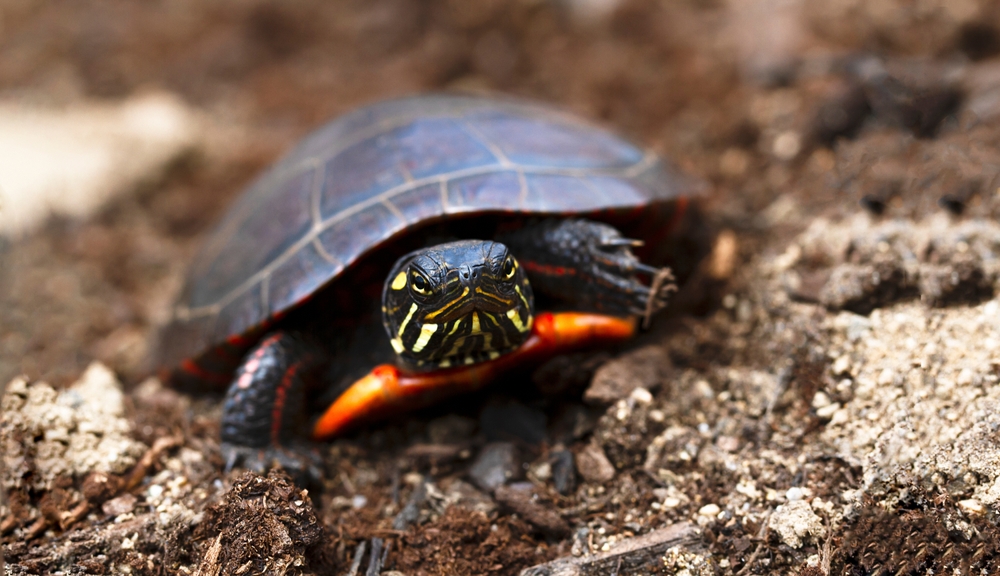Living Canvases: Understanding the Painted Turtle’s Unique Patterns

The Painted Turtle (Chrysemys picta) is renowned for its vibrant and distinctive shell patterns, making it one of North America’s most visually striking reptiles. These intricate designs are not only beautiful but serve various functions in the turtle’s life. In this article, we delve into the Painted turtle shell designs, exploring their unique patterns, their evolutionary significance, and how they contribute to the turtle’s survival in the wild.
The Artistry of Painted Turtle Shell Patterns
The Painted Turtle’s shell is a living canvas, adorned with patterns that can vary based on age, subspecies, and individual differences. Here’s a closer look at the distinctive features of their shell:
- Colorful Plastron and Carapace: The Painted Turtle’s shell is divided into two main sections: the carapace (the upper part) and the plastron (the lower part). The carapace often exhibits a range of colors, including shades of black, green, and orange, with bright, contrasting markings. The plastron is typically yellow or cream-colored, sometimes featuring dark spots or lines. These vivid colors and patterns are designed to catch the eye, making the turtle appear striking and memorable.
- Pattern Variations: Each Painted Turtle has a unique shell pattern, much like human fingerprints. The patterns can include intricate lines, spots, and swirls that are not only aesthetically pleasing but also serve practical purposes. For instance, the bright colors and bold patterns can act as a deterrent to potential predators by making the turtle appear larger or more dangerous than it is.
- Adaptations for Camouflage: While the Painted Turtle’s bright colors might seem like a disadvantage in terms of camouflage, the patterns actually serve a dual purpose. In their natural habitats, these turtles often bask in the sun or hide among vegetation. The patterns on their shells can break up their outline and provide effective camouflage against the dappled light and shadows in their environment.
Significance of Shell Patterns in the Wild
The Painted Turtle’s shell patterns are more than just ornamental; they play a crucial role in their survival. Here’s how these designs impact their life:
- Social Signaling: In the social interactions of Painted Turtles, shell patterns can be a form of communication. For example, during mating rituals or territorial disputes, the visual cues provided by their shell patterns can convey information about their health, size, and reproductive status. Bright and well-defined patterns can signal a healthy and dominant individual.
- Thermoregulation: The colors and patterns on the Painted Turtle’s shell can also aid in thermoregulation. The ability to absorb or reflect sunlight effectively helps the turtle regulate its body temperature. The varying colors and patterns can enhance their ability to bask efficiently, which is crucial for maintaining optimal body temperature and overall health.
- Protection from Predators: The elaborate designs on the Painted Turtle’s shell can provide some level of protection from predators. The bright colors and complex patterns may confuse or intimidate potential threats, reducing the likelihood of an attack. Additionally, the hard, protective shell serves as a physical barrier against predators.
Caring for Painted Turtles in Captivity
For those who keep Painted Turtles as pets, understanding their shell patterns is just one aspect of their care. Here are some tips for maintaining their well-being in captivity:
- Appropriate Habitat: Create an environment that mimics their natural habitat as closely as possible. Provide a spacious tank with both aquatic and terrestrial areas. Ensure that the water is clean and properly filtered, and include basking areas with UVB lighting to support shell health and overall well-being.
- Balanced Diet: Feed your Painted Turtle a varied diet that includes commercial turtle food, fresh vegetables, and occasional protein sources. A balanced diet is essential for maintaining healthy shell patterns and preventing nutritional deficiencies.
- Regular Health Checks: Monitor your turtle’s shell for any signs of damage, disease, or changes in pattern. Regular veterinary check-ups can help address any health issues and ensure that your turtle remains in good condition.
Conclusion
The Painted Turtle’s shell is more than just a beautiful display; it is a testament to the evolutionary adaptations that enhance their survival in the wild. Understanding the Paintings of turtle shell designs provides insight into their behaviors, adaptations, and ecological roles. By appreciating and caring for these remarkable reptiles, you contribute to their conservation and well-being. Whether in the wild or in captivity, the Painted Turtle’s shell remains a living canvas, showcasing the intricate artistry of nature.This resource offers valuable insights into their remarkable shell patterns and their significance in the natural world.

Typical creator. Subtly charming web advocate. Infuriatingly humble beer aficionado.



